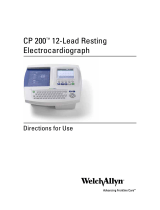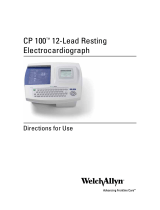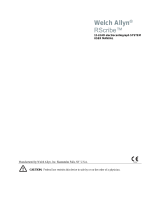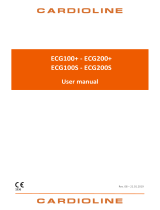Page is loading ...

CP 150 12-lead resting
electrocardiograph
Directions for use
Software version 2.10.XX

© 2016 Welch Allyn, Inc. All rights are reserved. To support the intended use of the product described in this
publication, the purchaser of the product is permitted to copy this publication, for internal distribution only, from the
media provided by Welch Allyn. No other use, reproduction, or distribution of this publication, or any part of it, is
permitted without written permission from Welch Allyn.Welch Allyn assumes no responsibility for any injury, or for
any illegal or improper use of the product, that may result from failure to use this product in accordance with the
instructions, cautions, warnings, or indications for use published in this manual.
Welch Allyn is a registered trademark of Welch Allyn, Inc. CP 150, and CardioPerfect are trademarks of Welch Allyn,
Inc.
Patent information
For patent information, please visit www.welchallyn.com/patents.
Software in this product is copyright Welch Allyn or its vendors. All rights are reserved. The software is protected by
United States of America copyright laws and international treaty provisions applicable worldwide. Under such laws,
the licensee is entitled to use the copy of the software incorporated within this instrument as intended in the
operation of the product in which it is embedded. The software may not be copied, decompiled, reverse-engineered,
disassembled or otherwise reduced to human-perceivable form. This is not a sale of the software or any copy of the
software; all right, title and ownership of the software remains with Welch Allyn or its vendors.
For information about any Welch Allyn product, contact Welch Allyn Technical Support: http://www.welchallyn.com/
106580 (CD)
DIR 80020057 Ver. D
This manual applies to the 901049 ELECTROCARDIOGRAPH
Welch Allyn, Inc.
4341 State Street Road
Skaneateles Falls, NY 13153 U.S.A
www.welchallyn.com
Regulatory Affairs Representative
Welch Allyn Limited
Navan Business Park
Dublin Road
Navan, County Meath
Republic of Ireland
Revision date: 2016-05

Contents
Introduction ............................................................................................. 1
About this document ........................................................................................... 1
Intended use ........................................................................................................ 1
Indications for use ................................................................................................ 1
Contraindications ................................................................................................. 1
Description ........................................................................................................... 1
Features ............................................................................................................... 2
Configuration options for CP150 electrocardiograph ........................................... 3
Controls, indicators, and connectors .................................................................... 5
Symbols ............................................................................................................... 7
General warnings ............................................................................................... 10
General cautions ................................................................................................ 12
Setup ...................................................................................................... 15
Connecting the patient cable ............................................................................. 15
Loading the thermal paper ................................................................................. 15
Powering the electrocardiograph ....................................................................... 16
Secure the AC power cord around the cord wrap of the mobile stand ............. 17
Verifying proper operation .................................................................................. 17
ECG home screen .................................................................................. 19
ECG home screen .............................................................................................. 19
ECG tests ................................................................................................ 23
Attach the leads to the patient ........................................................................... 23
View electrode placement ................................................................................. 24
Electrode locations ............................................................................................. 25
Use the New Patient tab to perform an Auto ECG test .................................... 26
Saved tests ............................................................................................. 31
Search for saved tests ....................................................................................... 31
Manage the saved tests .................................................................................... 31
Manage worklist .................................................................................... 33
Download the worklist when connected to the Worklist server ........................ 33
Settings .................................................................................................. 35
View or change the ECG settings ...................................................................... 35
View or change the device information ............................................................. 37
Advanced settings ................................................................................. 39
Access Advanced settings ................................................................................. 39
iii

Regional ............................................................................................................. 39
Device ................................................................................................................ 40
Data management ............................................................................................. 41
Ownership ......................................................................................................... 41
Start Demo ......................................................................................................... 42
Network ............................................................................................................. 42
Service ............................................................................................................... 49
Maintenance .......................................................................................... 53
Cleaning the equipment ..................................................................................... 53
Inspecting the equipment .................................................................................. 54
Testing the electrocardiograph .......................................................................... 54
Replacing the battery ......................................................................................... 55
Replacing the AC fuses ...................................................................................... 55
Storing the equipment ....................................................................................... 56
Disposing of electronic equipment .................................................................... 56
Troubleshooting .................................................................................... 57
Lead-quality problems ........................................................................................ 57
System problems ............................................................................................... 60
Service policy ........................................................................................ 63
Limited warranty ................................................................................... 65
General compliance and standards ..................................................... 67
Device radio ....................................................................................................... 67
General radio compliance ................................................................................... 69
Federal Communications Commission (FCC) .................................................... 69
Industry Canada (IC) emissions .......................................................................... 70
European Union ................................................................................................. 71
EMC guidance and manufacturer’s declarations ............................................... 72
Specifications ........................................................................................ 77
Appendix ................................................................................................ 81
Approved accessories ........................................................................................ 81
iv Contents CP 150 12-lead resting electrocardiograph

Introduction
About this document
This document is written for clinical professionals with a working knowledge of medical
procedures and terminology required for monitoring cardiac patients.
Before using the electrocardiograph for clinical applications — or before setting up,
configuring, troubleshooting, or servicing the electrocardiograph — you must read and
understand this document and all other information that accompanies the
electrocardiograph and related options or accessories.
Intended use
The Welch Allyn CP150 ™ is an electrocardiograph used to process the electrical signal
transmitted through two or more electrocardiograph electrodes and to produce a visual
display of the electrical signal produced by the heart.
The CP150 ™ Electrocardiograph is specifically intended for acquiring and printing ECG
signals from adults and pediatric patients. It will be used in clinical settings by trained
healthcare providers. The optional interpretation algorithm analyzes these ECG signals to
generate measurements and interpretive statements. The interpretive results are
intended only as guidance for qualified physicians and must not be relied upon as
diagnoses.
Indications for use
The electrocardiograph is one of the tools that clinicians use to evaluate, diagnose, and
measure patient cardiac function.
The 12-lead optional interpretation algorithm provides a computer-generated analysis of
potential patient cardiac abnormalities, which must be confirmed by a physician with
other relevant clinical information.
Contraindications
The electrocardiograph has no known contraindications.
Description
• The electrocardiograph is not suitable for direct cardiac application.
• The electrocardiograph allows users to perform 12-lead ECG measurements and
analysis.
1

• The electrocardiograph supports STAT, Auto, and Rhythm test types.
• The electrocardiograph provides the ability to print test records on an internal printer.
• The electrocardiograph provides the ability to send test records and analysis directly
to an electronic medical records (EMR) system.
• The electrocardiograph allows storage of test records in device memory, external
storage media, and external software applications.
• The electrocardiograph allows users to enter patient demographic data into the
electrocardiograph memory to be recalled for a test later that day.
Features
Pacemaker detection
The software detects the possible presence of a pacemaker. If you confirm that the
patient has a pacemaker, the ECG report includes no interpretation, and it indicates that
a pacemaker was detected.
WiFi connectivity (optional)
The optional WiFi capability allows for wireless connectivity and enhanced workflow
alternatives. Reduces the reliance on a wired connection.
DICOM format support (optional)
The optional DICOM capability enables direct communication with PACS and EMR
systems. Acquire worklist orders and share 12-lead ECG waveforms with the recipient
system to enhance workflow efficiency.
Automatic ECG interpretation (optional)
The optional MEANS interpretation algorithm, developed by the University of Rotterdam
in the Netherlands, provides automatic analysis of ECG tests. For more information, see
the MEANS Physicians’ Manual or the PEDMEANS Physicians’ Manual on the CD that
came with your electrocardiograph. The MEANS algorithm is used for adult patients 18
years and older. The PEDMEANS algorithm is used for pediatric patients from 1 day
through 17 years old.
CAUTION Check for the presence of a pacemaker before using ECG with
interpretation.
WARNING A computer generated interpretation cannot replace sound
medical reasoning by a trained professional. Therefore, a physician should
always review the interpretation.
Spirometry (optional)
The CP 150 spirometry option allows the user to acquire, view, store, and print,
measures and waveforms of pulmonary function including, but not limited to, maximal
volume and flow of air that can be moved in and out of a patient's lungs. These
2
Introduction CP 150 12-lead resting electrocardiograph

measures are used in the diagnosis and monitoring of lung diseases and interventions
for the treatment of certain lung diseases.
Configuration options for CP150 electrocardiograph
Model Accessories Language Power cord
CP150 1 - AHA, disposable EN - English 2 - Europe
A - Interpretation 2 - IEC, disposable FR - French 3 - Israel
W - WiFi 3 - AHA, reusable DE - German 4 - UK
D - DICOM 4 - IEC, reusable ES - Spanish 5 - Switzerland
NL - Dutch 66 - Australia
BP - Brazilian
Portuguese
7 - S. Africa
PT - Portuguese B - North America
ZH - Simplified
Chinese
C - China
RU - Russian G – Argentina
NO - Norwegian N – India/UAE
SV - Swedish Z - Brazil
DA - Danish
FI - Finnish
IT - Italian
TR - Turkish
KN - Korean
TC - Traditional
Chinese
Examples: CP150-1ENB, CP150A-1ENB, CP150WD-1ENB, CP150W-1ENB,
CP150A-4DE5
Configurations for CP150 electrocardiograph with spirometry option
Model
Accessories Language Power cord
CP150 1 - AHA, disposable EN - English B - North America
A - Interpretation 2 - IEC, disposable
Directions for use Introduction 3

Model Accessories Language Power cord
S - Spirometry 3 - AHA, reusable
W - WiFi 4 - IEC, reusable
Note The spirometry option is only available in English.
Examples: CP150S-1ENB and CP150AS-1ENB
4 Introduction CP 150 12-lead resting electrocardiograph

Controls, indicators, and connectors
No. Feature Description
1 LCD screen 800 x 480 pixels color touchscreen provides a graphical user
interface.
2 Power switch and LED Power-on/Standby switch.
The LED indicates the charging status when connected to AC
power:
• Green: The battery is charged.
• Amber: The battery is charging.
3 Patient cable connector Provides connection for patient cable.
4 Printer Printer provides a printout of patient Auto ECG, Stat ECG, or
Rhythm ECG.
Directions for use Introduction 5

Back view
No. Feature Description
1 Ethernet connector Provides a hardwired connection to the computer network.
The LEDs indicate active network status when the ethernet cable
is connected to a network.
2 Clients USB USB, type "mini B." Provides connection to an enabled host.
3 Host USB USB, type "A." Provides four host USB connections for optional
accessories.
4 Power connection Provides an external AC power connection.
5 AC fuse Provides access to AC fuse.
6 Ground lug (equipotential terminal) Provided for electrical safety testing and as a means for
connection of a potential equalization conductor.
7 Battery compartment (behind cover) Houses the Li-ion battery.
6 Introduction CP 150 12-lead resting electrocardiograph

Symbols
Documentation symbols
WARNING The warning statements in
this manual identify conditions or
practices that could lead to illness, injury,
or death.
Caution The caution statements in this
manual identify conditions or practices
that could result in damage to the
equipment or other property, or loss of
data. This definition applies to both
yellow and black and white symbols.
Consult directions for use (DFU). A copy
of the DFU is available on this website. A
printed copy of the DFU can be ordered
from Welch Allyn for delivery within 7
calendar days.
Meets essential requirements of the
European Medical Device Directive 93/
42/EC
Power symbols
Power on/standby
Battery
Alternating Current power present,
battery fully charged
Battery absent or faulty
Alternating Current power present,
battery is charging
Battery charge level
Alternating current (AC)
Battery Charging - AC powered
Dangerous voltage
Power plug
Fuse
Li-ion
Rechargeable battery
Protective Earth (PE) Rated power input, AC
Equipotential Ground
Directions for use Introduction 7

Connectivity symbols
USB
Ethernet
Wireless radio symbols
Wireless signal strength
• Best (4 bars)
• Good (3 bars)
• Fair (2 bars)
• Weak (1 bar)
• No connection (no bars)
Non-ionizing electromagnetic radiation
FCC ID
The identification number assigned by
the Federal Communications Commission
SQG-WB45NBT
IC ID
Industry Canada identification number.
The equivalent governing body to the FCC
in the United States
3147A-WB45NBT
Australian Communications and Media
Authority (ACMA) Radio Compliance
Mark (RCM)
This device complies with Article 58-2
Radio Waves Act of Korea
Communications Commission.
Brazil: ANATEL Model No. 1130-15-8547
07898949039068
Shipping, storing, and environment symbols
This way up
Keep Dry
Fragile
Humidity limitation
Temperature limit Atmospheric pressure limitation
Separate collection of batteries. Do not
dispose as unsorted municipal waste.
Recyclable
8 Introduction CP 150 12-lead resting electrocardiograph

Separate collection of Electrical and
Electronic Equipment. Do not dispose as
unsorted municipal waste.
China RoHs
Lithium ion battery Keep away from sunlight
Use by Date
IP20
Protected against the ingress of solid
foreign objects ≥ 12.5 mm diameter, not
protected against the ingress of water.
Miscellaneous symbols
Manufacturer
Defibrillation-proof Type CF applied part
Product Identifier Serial Number
Reorder Number Lot Code
Prescription only or "For Use by or on the
order of a licensed medical professional"
Do not re-use, Single use device
Authorized Representative in the
European Community
Global Trade Item Number
Call for maintenance Clock; time switch; timer
Directions for use Introduction 9

General warnings
Warnings indicate conditions or practices that could lead to illness, injury, or death.
Warnings related to the environment
WARNING The power cord is considered the disconnect device for
isolating this equipment from supply mains. Do not position the equipment
so that it is difficult to reach or disconnect.
WARNING To avoid a possible explosion, do not use the
electrocardiograph in the presence of flammable anesthetics: mixtures
containing air, oxygen, or nitrous oxide.
WARNING When transporting the electrocardiograph on a cart, tuck the
patient cable away to keep them clear of the wheels and to minimize trip
hazards.
Warnings related to accessories and other equipment
WARNING To avoid the risk of electric shock, this equipment must only
be connected to a supply mains with protective earth.
WARNING For operator and patient safety, peripheral equipment and
accessories that can come in direct patient contact must be in compliance
with all appropriate safety, EMC, and regulatory requirements.
WARNING All signal input and output (I/O) connectors are intended for
connection of only devices complying with IEC 60601-1, or other IEC
standards (for example, IEC 60950), as appropriate to the device.
Connecting additional devices to the electrocardiograph might increase
chassis or patient leakage currents.
WARNING The electrocardiograph has not been designed for use with
high-frequency (HF) surgical equipment and does not protect against
hazards to the patient.
WARNING Defective batteries can damage the electrocardiograph.
Visually inspect the battery at least monthly, if the battery shows any signs
of damage or cracking, it must be replaced immediately and only with a
battery approved by Welch Allyn.
WARNING Improper disposal of batteries may create an explosion or
contamination hazard. Never dispose of batteries in refuse containers.
Always recycle batteries according to local regulations.
WARNING All signal input and output (SIP/SOP) connectors should not be
contacted by patient directly and indirectly through the user during
operation.
WARNING Use only parts and accessories, including thermal paper, that
were supplied with the device and available through Welch Allyn. The use
of accessories other than those specified may result in degraded
performance or unsafe use of this device.
10 Introduction CP 150 12-lead resting electrocardiograph

Warnings related to using the electrocardiograph
WARNING No modification of this equipment is allowed.
WARNING This device captures and presents data reflecting a patient’s
physiological condition. When reviewed by a trained physician or clinician,
this data can be useful in determining a diagnosis. However, the data
should not be used as a sole means for determining a patient’s diagnosis or
prescribing treatment.
WARNING To provide CF protection use only accessories approved by
Welch Allyn. Visit www.welchallyn.com. The use of any other accessories
can result in inaccurate patient data, can damage the equipment, and can
void your product warranty.
WARNING To avoid serious injury or death, take these precautions during
patient defibrillation:
• Avoid contact with the electrocardiograph, patient cable, and patient.
• Verify that the patient leads are properly connected.
• Place defibrillator paddles properly in relation to electrodes.
• After defibrillation, pull each patient lead out of the patient cable and inspect
the tips for charring (black carbon marks). If there is any charring, the patient
cable and individual leads must be replaced. If there is no charring, fully
reinsert the leads into the patient cable. (Charring can occur only if a lead is
not fully inserted into the patient cable before defibrillation.)
WARNING To prevent the spread of infection, take these precautions:
• Dispose of single-use components (for example, electrodes) after using
them once.
• Regularly clean all components that come in contact with patients.
• Avoid ECG testing for patients with open, infectious sores.
WARNING Avoid positioning any leads or cables so that they could easily
trip someone or become wrapped around a patient’s neck.
WARNING To ensure safe use of the device, follow the documented
maintenance procedures.
WARNING Only qualified service personnel should attempt to repair the
electrocardiograph. In case of a malfunction, call Technical Support.
WARNING Do not perform ST segment analysis on the ECG screen
display, since these ECG representations are scaled. Make manual
measurements of ECG intervals and magnitudes on printed ECG reports
only.
WARNING To maintain diagnostic accuracy and to comply with IEC
60601-02-51 and IEC 60601-02-25, do not scale (re size) when sending a
saved ECG to an external printer.
WARNING To avoid injury, do not touch the print head immediately after
printing. It might be hot.
Directions for use Introduction 11

WARNING To avoid the risk of associating reports with the wrong
patients, make sure that each test identifies the patient. Do not save a test
to the patient record without patient identification associated with the
report.
General cautions
Cautions indicate conditions or practices that could damage the equipment or other
property.
CAUTION Federal US law restricts sale of the device identified in this
manual to, or on the order of, a licensed physician.
CAUTION When removing the electrocardiograph from storage, allow it to
thermally stabilize to surrounding environmental conditions before using it.
CAUTION To prevent possible damage, do not use sharp or hard objects
to press the touch screen or the buttons. Only use fingertips.
CAUTION Do not expose the patient cable to strong ultraviolet radiation.
CAUTION Do not pull or stretch the patient cable. Doing so could result in
mechanical or electrical failures. Form the patient cable into a loose loop
before storing.
CAUTION Avoid positioning the patient cable where it might get pinched,
stretched, or stepped on. Otherwise, measurements might no longer be
accurate, and repair might be necessary.
CAUTION Using the equipotential terminal for anything but grounding
purposes may contribute to damage of the device.
CAUTION Portable and mobile RF communications equipment can affect
the performance of the electrocardiograph.
CAUTION The electrocardiograph meets the Class A requirements of IEC
60601-1-2 regarding incidental emission of radio frequency interference. As
such it is suitable for use in commercial grade electrical environments. If
the electrocardiograph is used in residential grade electrical environments
and you experience incidental interference with other equipment that uses
radio frequency signals to operate, minimize the interference.
CAUTION Other medical equipment—including but not limited to
defibrillators, ultrasound machines, pacemakers, and other stimulators—
may be used simultaneously with the electrocardiograph. However, such
devices may disturb the electrocardiograph signal.
CAUTION The power cord must be disconnected from AC power before
cleaning, maintaining, transporting, or servicing.
12 Introduction CP 150 12-lead resting electrocardiograph

CAUTION The requirements of AAMI EC11, Section 3.2.7.2, Frequency
and Impulse Response, for an impulse triangle waveform may be impacted
by up to 5 milliseconds of small amplitude dampened ringing immediately
after the impulse when the muscle filter (35 Hz) is turned on or a small
amplitude offset when the baseline filter (0.5 Hz) is turned on. These filters,
in any combination turned on or off, meet the AAMI requirements.
Measurements performed by the optional interpretation algorithm are
unaffected by any filter selections.
Note The entire patient cable, up to and including the electrodes are considered
to be an Applied Part.
Directions for use Introduction 13

14 Introduction CP 150 12-lead resting electrocardiograph

Setup
Connecting the patient cable
WARNING Do not allow the conductive parts of the patient cable,
electrodes, or associated connections of defibrillation-proof applied parts,
including the neutral conductor of the patient cable and electrodes, to
come into contact with other conductive parts, including earth ground.
Otherwise, an electrical short might result, risking electric shock to patients
and damage to the device.
WARNING To avoid injury to the patient or damage to the device, never
plug patient leads into any other device or wall outlet.
WARNING To provide CF protection use only accessories approved by
Welch Allyn. Visit www.welchallyn.com. The use of any other accessories
can result in inaccurate patient data, can damage the equipment, and can
void your product warranty.
CAUTION Always connect the patient cable and the leads properly during
defibrillation. Otherwise, the connected leads could be damaged.
Loading the thermal paper
The electrocardiograph prints on z-fold thermal paper.
•
Store the paper in a cool, dry, dark place.
• Do not expose it to bright light or UV sources.
• Do not expose it to solvents, adhesives, or cleaning fluids.
• Do not store it with vinyls, plastics, or shrink wraps.
15

Powering the electrocardiograph
The electrocardiograph runs on AC or battery power. Plug the electrocardiograph into AC
power as often as possible so that the built-in charger can keep the battery charged.
Regardless of the battery condition, you can use the electrocardiograph whenever it is
plugged in.
WARNING When you use AC power, always plug the electrocardiograph
into a hospital-grade outlet to avoid the risk of shock.
WARNING If the integrity of the building’s safety ground is in doubt,
operate this device on battery power to avoid the risk of shock.
To turn on or turn off
Press .
16 Setup CP 150 12-lead resting electrocardiograph
/










